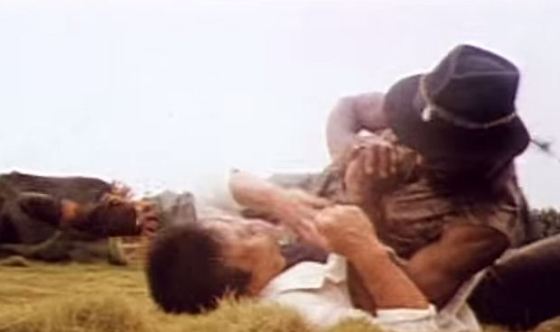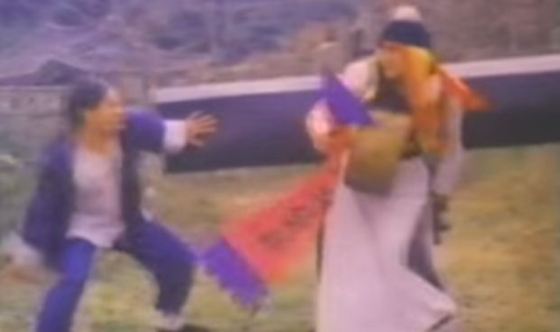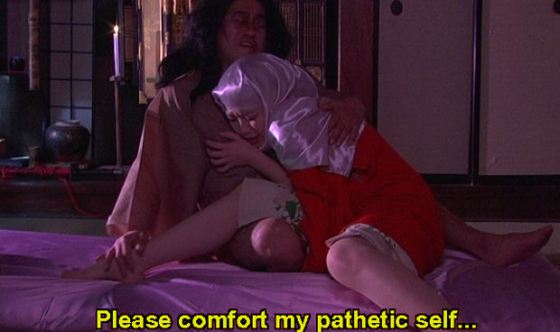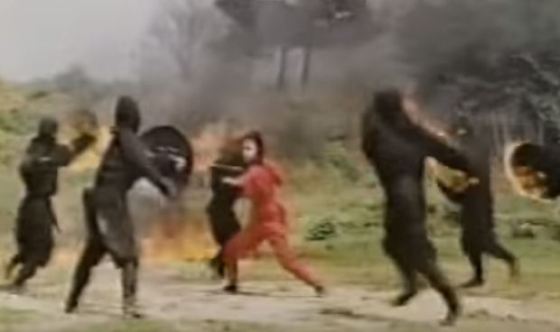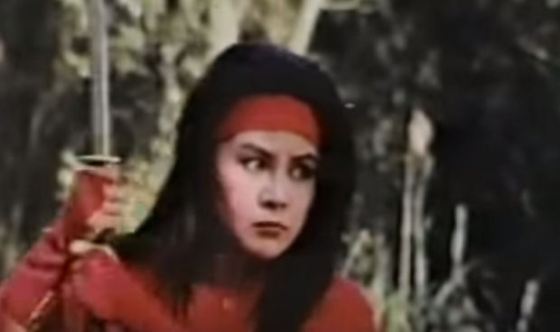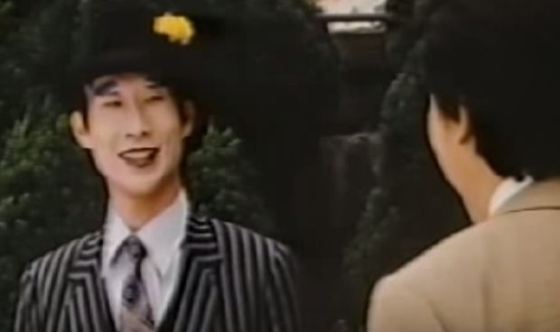Wu Kuo-Ren and Alexander Lou are up to their old tricks again and if you’ve seen The Super Ninja, Wu Tang vs Ninja or any of their other collaborations, you’ll have some idea what to expect from Ninja Condors. However, this turns the action and the melodrama up to inconceivable levels to produce a hugely entertaining piece of work; easily one of the best productions to bear the Filmark production house’s name. Well, I say “best”… I suppose you’ve got to be quite deep into the ninja hole before this is in any way “good” but, on the other hand, a film that delivers so earnestly on its promise of excessive ninjing, creative mindless violence and wildly OTT dialogue, can’t possibly be deemed “bad” in my eyes. I loved it.
The first few minutes of the film play more like a trailer than an opening – scenes of close-up action frantically cut together with little concession to whether the audience will follow what’s going on. To begin with, a man is murdered. He’s dragged along a beach by a rope tied to the back of a motorbike while his child watches on in horror. The kid gets rescued by a friendly cop named Tyler and we flash forward some twenty years to find the kid is now a man and played by Alexander Lou. His name is Brian but he’s better known as “The White Eagle”, part of an elite band of ninja assassins who work for a super-evil crime boss called Lucifer. Still in this opening montage, Lucifer takes Brian to the home of some other criminals, tells him “Those are the men who killed your father!” and lets Brian ninj the Hell out of them with blowpipes and shuriken. That’s pretty much an entire film’s worth of plot for this genre normally, but barely a prologue for Ninja Condors!
Lucifer’s goal in life is to exterminate all his rivals. The “cops” (who all look and act like they’ve been cast from an under-achieving high school drama club) are on his trail but Lucifer has decided they all need to die too. In a haze of megalomaniacal paranoia, Lucifer questions Brian’s loyalty, kidnaps Tyler, crucifies him against a fence and asks Brian to murder him. Brian refuses so Lucifer gets another of his ninjas to take a chainsaw to Tyler’s pregnant wife’s stomach (!). Brian, horrified by this, is thrown out of the ninja club but it’s not all bad. He decides that, along with his cockney girlfriend Mabel, they can use this as a reason to go live their dream of owning a chicken farm. But it’s no good. They’re about to leave for the country but Lucifer’s planted a bomb in Brian’s car! It blows Mabel sky high!
Phew. All of this is still only covering the first act. The film’s story begins in earnest when Brian – now on the run from Lucifer – meets a live-wire vagrant named Eddie (Eugene Thomas!) in a bar. Eddie is busy hustling people for drinks and flirting with girls. He finds one at a table with four white guys and lays down the classic pick-up line “I can read palms. Do you know what I see in yours? I see four honkies, honking out on ya!” but it doesn’t go down so well and a fight breaks out. When he drags Brian into the brawl, they soon become unlikely but firm friends.
From there the plot almost becomes a proper old-fashioned kung fu story about two brawling wanderers on the run from an evil master. Brian and Eddie get into all kinds of trouble. They’re arrested for vagrancy (“We might get the electric chair!” screams Eddie. “You know what I’m talking about! Barbecue!”) and wind up in a dozen fights with various ninjas before eventually making their way to a glorious final showdown at Lucifer’s luxury mansion.
From a technical point of view, Ninja Condors is pretty awful. It’s horribly photographed and sometimes hard to follow. Alexander Lou’s hairstyle is of dubious continuity, his trademark mullet often changing length within the space of a scene, and there are more errors like this to spot if you’re looking but, really, it’s a lot more fun if you just sit back and enjoy the ninjing. We’ve got exploding ninjas galore, insane ninja rope tricks, magical shuriken that blow things up, disappearing ninjas, ninjas splitting into five and then reforming as one… Not to mention a couple of precious moments unique to Ninja Condors like…
…NINJAS ON A CAROUSEL…
…AND NINJAS ON ICE!
The finalé here is absolutely off the chain. It builds up through a series of intensely melodramatic scenes of dialogue that must be seen to be believed. I’m sure the over-earnest dubbing makes them seem sillier than they should be but the words are just fantastic, especially the one where Brian’s master explains to him The True Way Of The Ninja and the one where Eddie and Brian declare their undying friendship on the beach. After this life-or-death scene is set with such severity, Brian and Eddie go utterly nuts in Lucifer’s mansion using anything they can get their hands on as a weapon (model aeroplanes, goat’s skulls, you name it), expending somewhere in the region of a billion bullets, and pushing the body count way higher than is usual for a film of this budget. Overkill doesn’t even begin to cover it. To make it better, Eugene Thomas does the whole thing while wearing a weird Crocodile Dundee outfit with tassled boots.
The action’s all pretty scrappy but so unbelievably violent and overblown that you won’t care. I can’t even imagine what was going through their heads when they filmed it but it feels sincere. Like they were really trying hard. It feels like they just wanted to give the audience what they loved; big guns, high body counts, natty ninja suits and huge, broadly painted emotions. If this had been played for laughs it would be far less entertaining but the fact that it keeps such a straight face even at the heights of its lunacy makes Ninja Condors a strange and wonderful picture. Highly recommended.








